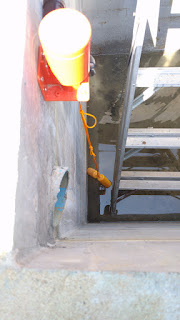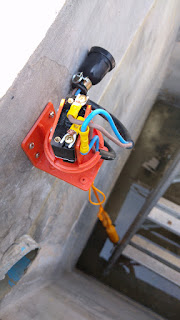Since the aerobic treatment system (ATS) dumps the water out into a 1 cubic meter cistern below the ground, and the slow sand filter we want to use to filter this is above ground about 5 meters away, we are using a large aquarium pump to pump the effluent in the cistern to the slow sand filter for secondary treatment.
We don’t seem to be producing that much waste water given that three of us are living in the house. It looks like 3 days of waste water fills up the cistern about 30%-50%, coming out to about 100-150 liters of water per day. So up to this point, I’ve been manually turning on and off the pump every day or two to make sure the cistern doesn’t fill up.
But the plan was always to install a float switch so that whenever water in the cistern got to a certain level, the pump would automatically turn on, and then when the water gets down to a certain lower level, the pump would automatically turn off.
K’Tanawat and I finally got around to installing the float switch this week:
The switch mechanism is under the orange plastic cover in the upper left, and a rope comes down to the floats in the water down below.
Here is a wider view:
The AC 220V power comes in through a hole in the top/side of the cistern, runs through the switch under the orange plastic, and then out to a socket that the pump can plug into.
Here is a closer up picture of the insides of the switch under the cover:
The switch has two pairs of contacts. One is open when the water level is low and closed when the water level is high, while the other is open when the water level is high and closed when the water level is low. In other words, you can use one for pumping water out of a tank when the water gets too high, and the other for pumping water into a tank when the water gets too low.
We are running the line (tan) wire through the switch and the neutral (blue) wire straight from the mains to the socket.
If I ever get around to building a 24VDC to 220VAC inverter, then we will be able to run this pump off of the solar panels. (Along with the air pump on the ATS, which is also run from the same circuit.)


